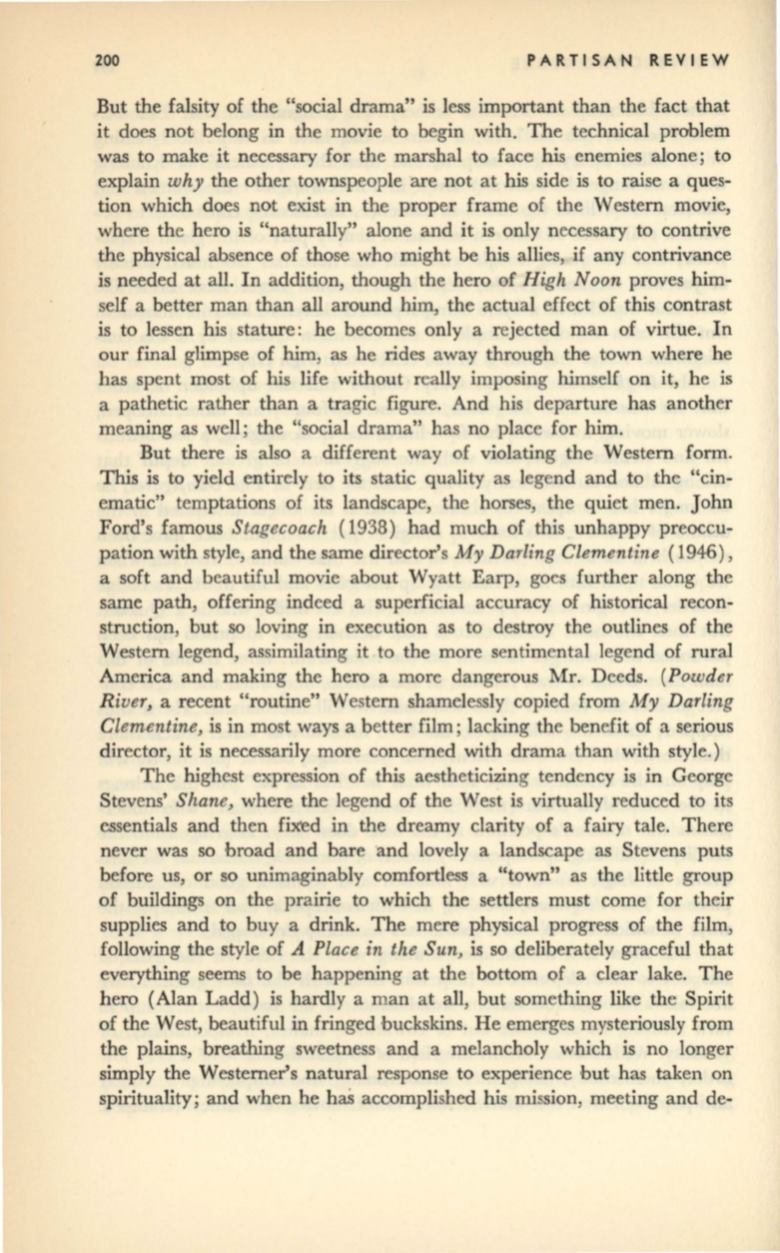
200
PARTISAN REVIEW
But the falsity of the "social drama" is less important than the fact that
it does not belong in the movie to begin with. The technical problem
was to make it necessary for the marshal to face his enemies alone; to
explain
why
the other townspeople are not at his side is to raise a ques–
tion which does not exist in the proper frame of the Western movie,
where the hero is "naturally" alone and it is only necessary to contrive
the physical absence of those who might
be
his allies, if any contrivance
is needed at all. In addition, though the hero of
High Noon
proves him–
self a better man than all around him, the actual effect of this contrast
is to lessen his stature: he becomes only a rejected man of virtue. In
our final glimpse of him, as he rides away through the town where he
has spent most of his life without really imposing himself on it, he is
a pathetic rather than a tragic figure. And his departure has another
meaning as well; the "social drama" has no place for him.
But there
is
also a different way of violating the Western form.
This is to yield entirely to its static quality as legend and to the "cin–
ematic" temptations of its landscape, the horses, the quiet men. John
Ford's famous
Stagecoach
(1938) had much of this unhappy preoccu–
pation with style, and the same director's
My
Darling Clementine
(1946),
a soft and beautiful movie about Wyatt Earp, goes further along the
same path, offering indeed a superficial accuracy of historical recon–
struction, but so loving in execution as to destroy the outlines of the
Western legend, assimilating it to the more sentimental legend of rural
America and making the hero a more dangerous Mr. Deeds.
(Powder
River,
a recent "routine" Western shamelessly copied from
My
Darling
Clementine,
is in most ways a better film; lacking the benefit of a serious
director, it is necessarily more concerned with drama than with style.)
The highest expression of this aestheticizing tendency is in George
Stevens'
Shane,
where the legend of the West is virtually reduced to its
e.5sentials and then fixed in the dreamy clarity of a fairy tale. There
never was so broad and bare and lovely a landscape as Stevens puts
before us, or so unimaginably comfortle.5s a "town" as the little group
of buildings on the prairie to which the settlers must come for their
supplies and to buy a drink. The mere physical progress of the film,
following the style of
A Place in the Sun,
is so deliberately graceful that
everything seems to be happening at the bottom of a clear lake. The
hero (Alan Ladd) is hardly a man at all, but something like the Spirit
of the West, beautiful in fringed buckskins. He emerges mysteriously from
the plains, breathing sweetness and a melancholy which is no longer
simply the Westerner's natural response to experience but has taken on
spirituality; and when he haS accomplished his mission, meeting and de-


